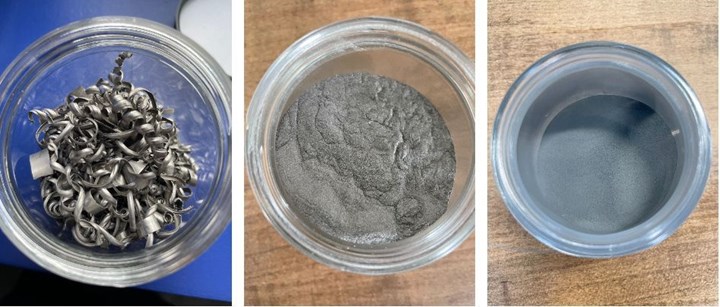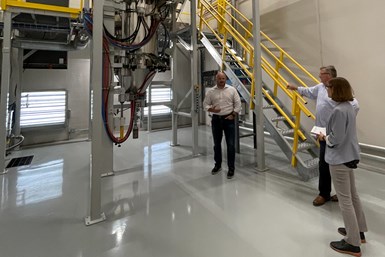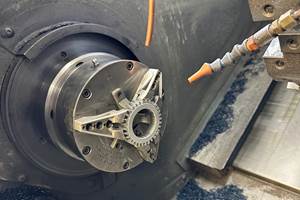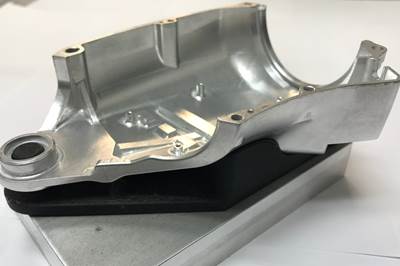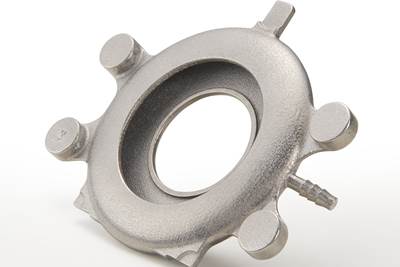Share


Recycling of chips and scrap metal is a matter of course for most machine shops; sending this material off to a processor is a way to reclaim some of the capital invested in stock that cannot be used otherwise. But what happens to that metal once it is out of sight? Is there a way to not just recycle, but upcycle, that material into something even more valuable?
This is part of the vision of 6K Additive, a materials processor based in Pennsylvania that has developed a way to turn various types of metal into high-value, infinitely flexible powders that can be applied in 3D printing. The technique can be used to refurbish leftover powder from the laser powder bed fusion (LPBF) process; refine oversized powder produced through gas atomization; or transform metal chips, grindings and even full parts into usable powder.
6K Additive has developed a process that cleans and mills metal chips like these turnings (left) into a mechanically sized powder (center), which is then passed through microwave plasma to be densified and spheriodized into metal powder suitable for additive manufacturing (right).
6K Additive uses a two-step process to do this. First, the feedstock material is cleaned and mechanically milled down to the desired size. Then, the particles are passed through a column of microwave plasma using one of the company’s UniMelt reactors. The plasma melts each particle just enough to densify and spheroidize the material into powder suitable for additive manufacturing (AM). Each pre-milled particle remains distinct during this step and cools quickly, so that the final powder can be collected soon after.
One of the UniMelt reactors at 6K Additive’s Pittsburgh-area plant. Read more about the company’s material processing technique.
By separating the sizing of powder from its densification and shaping 6K Additive has been able to overcome some of the challenges of gas atomization, a common means of producing metal additive manufacturing feedstock. In gas atomization, large amounts of metal are melted and dropped through a stream of gas to produce spherical particles; once cooled and solidified, the entire lot of material is then sieved and sorted into various grades, which can result in waste when powder that is too large or too small results.
In contrast, because the UniMelt reactors use material that is already pre-milled down to size, it is nearly a 1-to-1 process. Without the need to melt large amounts of material, it does not need to produce a large batch in order to be economical (and may be more energy efficient). The mechanical step can also support the production of alloys that would not be possible otherwise.
Thanks to mechanical milling and an efficient microwave plasma process, 6K Additive does not need to produce large batches of powder which can make new alloys and unusual materials more accessible.
But the potential of this technique extends beyond 6K Additive and even beyond additive manufacturing all together. A process that can make use of existing material rather than requiring virgin feedstock not only provides a home for scrap like machining chips, it also keeps valuable material local.
Consider that the United States has no domestic source for mining of titanium; like many other alloys, most of the stock comes from China so virgin titanium must be imported. Yet with an efficient recycling strategy, the U.S. could mine its own chip bins and aircraft boneyards and more for titanium feedstock. (6K Additive even envisions a future where large OEMs might have their own UniMelt reactors to convert scrap right on site.) And once converted into feedstock for additive manufacturing, the potential applications might be limitless.
Learn more about UniMelt and 6K Additive in this feature article on AdditiveManufacturing.Media.
Related Content
Siemens Expands Additive Manufacturing Initiatives
The company has added new AM technology to its Charlotte Advanced Technology Collaboration Hub and plans to establish an AM advisory board.
Read More6 Trends in Additive Manufacturing Technology
IMTS 2024 features a larger Additive Manufacturing Pavilion than ever before, with veteran suppliers alongside startups and newcomers at the front of the West Building. As you browse these exhibitors, as well as booths found elsewhere at the show, keep an eye out for these trends in AM.
Read MoreWhy This Moldmaker Thinks Every Shop Needs a 3D Printer
See how this mold shop uses polymer, carbon fiber and metal 3D printers to boost precision and productivity.
Read MoreChuck Jaws Achieve 77% Weight Reduction Through 3D Printing
Alpha Precision Group (APG) has developed an innovative workholding design for faster spindle speeds through sinter-based additive manufacturing.
Read MoreRead Next
Five 3D Printing Trends Mirrored in Machining
The underlying drivers of additive manufacturing’s advance are increasingly easy to spot on automated CNC machine shop floors.
Read MoreSafe, Smart, Sustainable, Stable — Dispelling the Manufacturing Myths
Manufacturing has had a bad rap for a long time. The 3-Ds — Dark, Dirty, Dangerous — are almost a universal cultural belief wherever you go and no matter with whom you speak.
Read MoreThe Value of a "Pathfinder Part" for Additive Manufacturing
Implementing additive manufacturing means starting somewhere. Seeking out the right pathfinder part can illustrate valuable lessons about the advantages of this technology.
Read More

.jpg;width=70;height=70;mode=crop)













